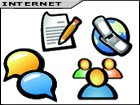
The primary mission of this blog is to promote awareness as to what is going on with technology and how it relates to the process of teaching and learning. Most teachers use the Internet to read and send e-mail, do a 'Google' search on a subject for class or use the information on a particular web page for their class. Technology has changed drastically over the past 5 years, the Internet has become a two way communication tool, using message boards, chat rooms, blogs and social networking sites. Many people have a general idea what a blog is and about the 'blogosphere,' but many don't have a good idea of what is really going on in the blogosphere! What is going on right now is the explosion of two way communication on the Internet, using social networking sites, tagging sites, peer production news, etc. Now, I know what you are thinking. There has been instant messaging, chat rooms, message boards, etc. all over the Internet for several years now, what do you mean there is an explosion going on now? The explosion that is going on now is that everyone and anyone can have an Internet presence and create, re-mix and draw new connections to anything they want. Because all of the content is accessible and easy to search and filter, anyone can become a content creator and have their ideas available for anyone to access.
Why am I telling you all of this now? Well, a study was recently released about how people use the Internet and what they use it for. The results will probably not surprize you, but should make you think, how can I use this level of interest to engage my students?
The PEW Internet and Life Project is a group that studies what people are doing on the Internet, which tools they are using and makes some predictions as to what people may be doing in the future. Recently, the group released a study about blogging; who is writing and who is reading this content and how it is effecting the social landscape of the world.
The full report from PEW Internet is here: Bloggers: A portrait of the internet's new storytellers, but the summary of the report is below.
- Blogging is brining new voices to the online world.
- Contrary to the impression created by the press attention on political blogging, just 11% of bloggers say they focus mainly on government or politics.
- The blogging population is young, evenly split between women and men, and racially diverse.
- 54% of all bloggers are between 18-29, yet they only account for 24% of the population online.
Hispanics account for only 11% of the online population, yet they account for 19% of all the bloggers.
- Relatively small groups of bloggers view blogging as a public endeavor.
- The main reasons for keeping a blog are creative expression and sharing personal experiences.
Blogging is usually the first foray into authorship; bloggers blog to express themselves creatively and share personal experiences.
- Sixty-two percent of bloggers did not have a personal website before launching their blog and 54% of bloggers had not published their writing or media creations anywhere else, either online or offline.
- Three in four bloggers (77%) told us that expressing themselves creatively was a reason that they blog.
- Only one-third of bloggers see blogging as a form of journalism. Yet many check facts and cite original sources.
- Bloggers are avid consumers and creators of online content. They are also heavy users of the internet in general.
- In February 2004, approximately 17% of Internet users said they had read a blog, since that time the number of Internet users that read blogs has risen to 39%, accounting for approximately 57 million adults in the United States.
- Bloggers will bring in media from other sources and remix the content they find online to create their own artistic creation.
- Bloggers are major consumers of political news and about half prefer sources without a particular political viewpoint.
- Bloggers prefer political news, and news in general, without a particular political viewpoint.
- Bloggers often utilize community and readership-enhancing features available on their blogs.
- Blogs gain attention, if only at a personal level. Nearly 60% of bloggers had been noticed by others, either through comments posted on their blog or by exchanging links to other sites. Blog writers are also enthusiastic blog readers.
Source: Lenhart, Amanda and Susannah Fox. Bloggers. Washington, DC: Pew Internet & American Life Project, July 19, 2006.
What does all of this mean for education and the use of technology in education? Lots of good stuff. If you look at some of these things, you start saying to yourself, "This is what I want my students to do." So, now I would ask you... what are you going to do with this information and how are you going to integrate it into your teaching repertoire?
Some great first steps:
1) Go back and read some of the previous posts on this blog and look at what interests you and how you can modify, remix or tweak it and use it right away.
2) Create your own 'Bloglines' account, subscribe to a few blogs and read them periodically and find ways to integrate the material you find there into your classes.
3) Take a look at the Capuchino Online Learning Community (OLC) site to get ideas on how to integrate technology into your classes.
4) Talk to the Technology Coordinator at your school or send an e-mail to Kyle Brumbaugh or Dominic Bigue to get more ideas about how to integrate technology into your classes. Start small and work up as you develop more skill.
No comments:
Post a Comment